
The Solar-Terrestrial Centre of Excellence (STCE) is a collaborative network of the Belgian Institute for Space Aeronomy, the Royal Observatory of Belgium and the Royal Meteorological Institute of Belgium.
 |
Published by the STCE - this issue : 9 Mar 2012. The Solar-Terrestrial Centre of Excellence (STCE) is a collaborative network of the Belgian Institute for Space Aeronomy, the Royal Observatory of Belgium and the Royal Meteorological Institute of Belgium. |
| Archive of the newsletters | Subscribe to this newsletter by mail |
The active region that caused all the harassment the last day, is still in an energetic mood. It fired of again an M light flash - solar flare peaking just after midnight (March 09). The satellite SOHO has a front view of the Sun. It detected a plasma cloud ejected into space. The cloud is heading earth with a speed of 750 km/s. The Earth will encounter first a shock and secondly the cloud itself, probably on March 11, early on March 12. The magnetic field imbedded in the plasma cloud is probably oriented in such a way that it interact very easy with the magnetic shield of Earth. We are possibly heading for another strong geomagnetic storm.
In the mean time, we are still experiencing a geomagnetic storm due to the arrival of the plasma cloud on March 08. The Earth is still under the influence of a high energy protons and electrons stream. This stream of particles is still blinding the satellite ACE. The particles are visible on the SOHO/LASCO images as spikes and dots. It gives a troubled view which it make it difficult for automated software to interpret the images.
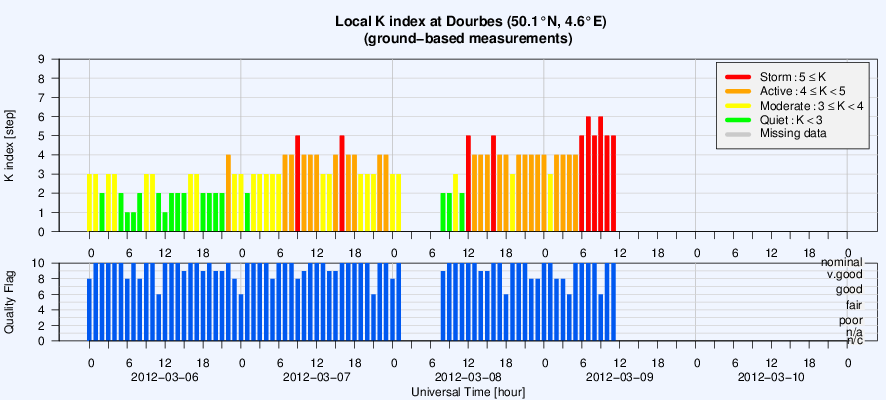
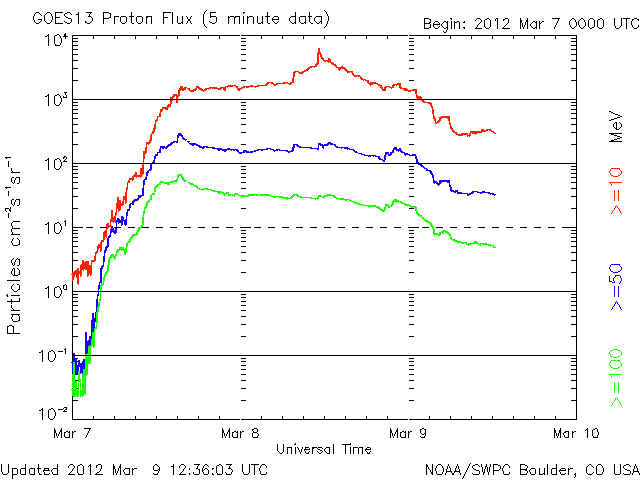
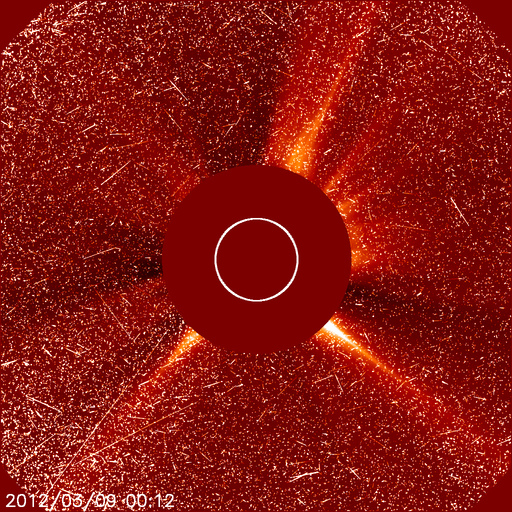
A very strong flare occurred on the Sun on March 07, 2012 around 1h30 Belgian time. A magnetized plasma cloud was ejected into space. The consequences for Belgium are for this moment limited. Updates are available on our website. The rise of activity is normal in this phase of the solar cycle and more and even stronger activity is expected in the next years.
SOLAR FLARE
Event: On March 07, 2012, around 1h30 Belgian time, an X5.4 flare was detected in the same sunspot group that produced the X1.1 flare on March 05.
Consequences for Belgium: Due to the position of Belgium on the night side of the Earth during the flare, no perturbation of the HF radio-communication occurred.
Next days: The sunspot group that produced the flare is still very large and complex. Another major flare is possible.
PLASMA CLOUD
Event: A magnetized plasma cloud was ejected around the same time. The cloud had a speed of around 2300 km/s. The arrival of the cloud at the Earth is expected in the course of March 08, 2012, with at least a strong geomagnetic storm (K=7) as a result.
Consequences for Belgium: We expect at least a strong geomagnetic storm (K=7) in the course of March 08, 2012, with some consequences for navigation (e.g. GPS) and satellites (drag force). Electricity networks may be slightly affected.
Aurora: Moderate chance for aurora in Belgium (when clear sky)
Next days: A similar plasma cloud could be ejected again.
PROTON STORM
Event: A stream of high-energy protons is strongly increased due to the ejection of the fast magnetized plasma cloud that drives a shock wave in front of it.
Consequences for Belgium: No effects on the ground. Aircraft at high altitude and high geographic latitudes may experience enhanced radiation levels.
Next Days: The stream of high-energy protons will stay above the event threshold at least until the arrival of the plasma cloud on March 08 and probably even longer.
Observed effects from this event worldwide: Impact on HF radio communication has been experienced in the southern hemisphere since 05:30 UT as a consequence of the proton storm.
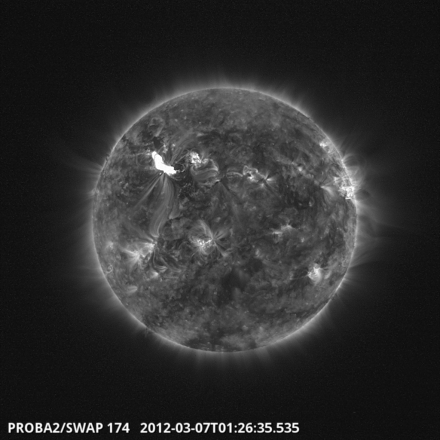
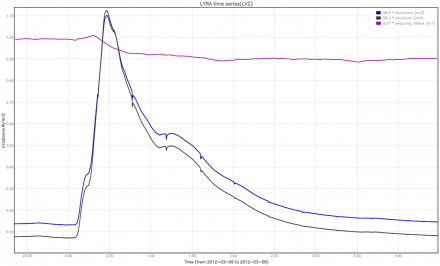
A strong flare occurred on the Sun on March 05, 2012 around 5h Belgian time. A plasma cloud was ejected into space. The consequences for Belgium were limited. Updates are available on our website .
SOLAR FLARE
Event: On March 05, 2012, around 5h Belgian time, an X1.1 flare was detected at the east side of the Sun (left on images).
Consequences for Belgium: weak degradation of the HF radio-communication above Belgium in the morning of March 05, 2012.
Next days: a similar event could occur, with stronger degradation of the HF communication above Belgium as a consequence.
PLASMA CLOUD
Event: A plasma cloud was ejected around the same time. The cloud had a speed of ~1000 km/s. Because the plasma cloud was not ejected straight to the Earth, only partially, we expect only a small impact on the Earth when the associated shock or cloud itself passes Earth. The initial speed in the direction of the Earth is estimated to be 890 km/s. The arrival at Earth is expected on March 07, 2012 between 5h and 17h Belgian time.
Consequences for Belgium: We expect a minor to moderate geomagnetic storm (K=5-6) on March 07, 2012 between 5h and 17h Belgian time, with limited consequences for navigation (e.g. GPS) and satellites (drag force). Electricity plants may be slightly affected.
Aurora: only a small chance for aurora in Belgium
Next days: a similar plasma cloud could be ejected with a possible stronger geomagnetic storm on Earth.
More http://www.sidc.be/news/146/welcome.html
For the third year in a row, Christophe Marque and Herve Lamy invite you to a "radio day" meeting which
aims at discussing present and future radio activities within the framework of the STCE.
The radio day will be organized on 15 May from 10:00 to 12:00 at the RMI meeting room.
This year, we plan to discuss the following topics :
- Protection of the radioastronomical observations in Humain (problems with windmills, querry, ...)
- Status of BRAMS and solar radio observations. Possible use of BRAMS data for characterization of solar flares.
- Future meteor radar in Dourbes
- Use of SDR system such as USRP2. Possibility to use it for solar observations in Humain.
Of course, this list covers only our activities and any additional topic is welcome. If you would like to attend
and possibly contribute to this radio day meeting, send an e-mail to herve.lamy at aeronomie.be or Christophe.Marque at oma.be.
Looking forward to meeting you in May.
Herve Lamy and Christophe Marque
On Feb 27, 28 and 29, there was some flaring activity in the B-level. March 01, a C-flare occurred. From March 02 onwards, active region NOAA 11429, still behind the east limb, increased the flaring level considerably. It started with an M3.3 flare, peaking at 17:46UT on March 02. A CME was associated with it. Due to the location of the source region, it was clear that the CME was not Earth directed. There was another M-flare on March 04 from the same active region, also associated with a CME. Again, because of the location of the source region at that moment, the CME was not ejected straight to Earth.
On Feb 26, 21UT, a shock passed the ACE satellite. The cloud itself followed 1 day later, around 18UT on Feb 27. The magnetic structure was associated with the filament eruption of Feb 24. At Dourbes, the shock and plasma cloud arrival induced a minor geomagnetic storm on Feb 27. On March 01, the local geomagnetic conditions pimped up to 4, active conditions. This could be the aftermath of the magnetic cloud.
| DAY | BEGIN | MAX | END | LOC | XRAY | OP | 10CM | TYPE | Cat | NOAA | NOTE |
| 2 | 1729 | 1746 | 1807 | N16E83 | M3.3 | SF | 0 | 1429 | Faint CME, directed to the East | ||
| 4 | 1029 | 1052 | 1216 | N19E61 | M2.0 | 1N | 2500 | IV/2 | 65 | 1429 |
| LOC: approximate heliographic location | TYPE: radio burst type |
| XRAY: X-ray flare class | Cat: Catania sunspot group number |
| OP: optical flare class | NOAA: NOAA active region number |
| 10CM: peak 10 cm radio flux |
On Friday 2nd, as well as on Sunday 4th, an active sunspot group (AR 11429) appearing on the East limb generated an M flare (and an X flare early, last Monday 5th):
M3.3 Flare on Fri March 02 at 18h27
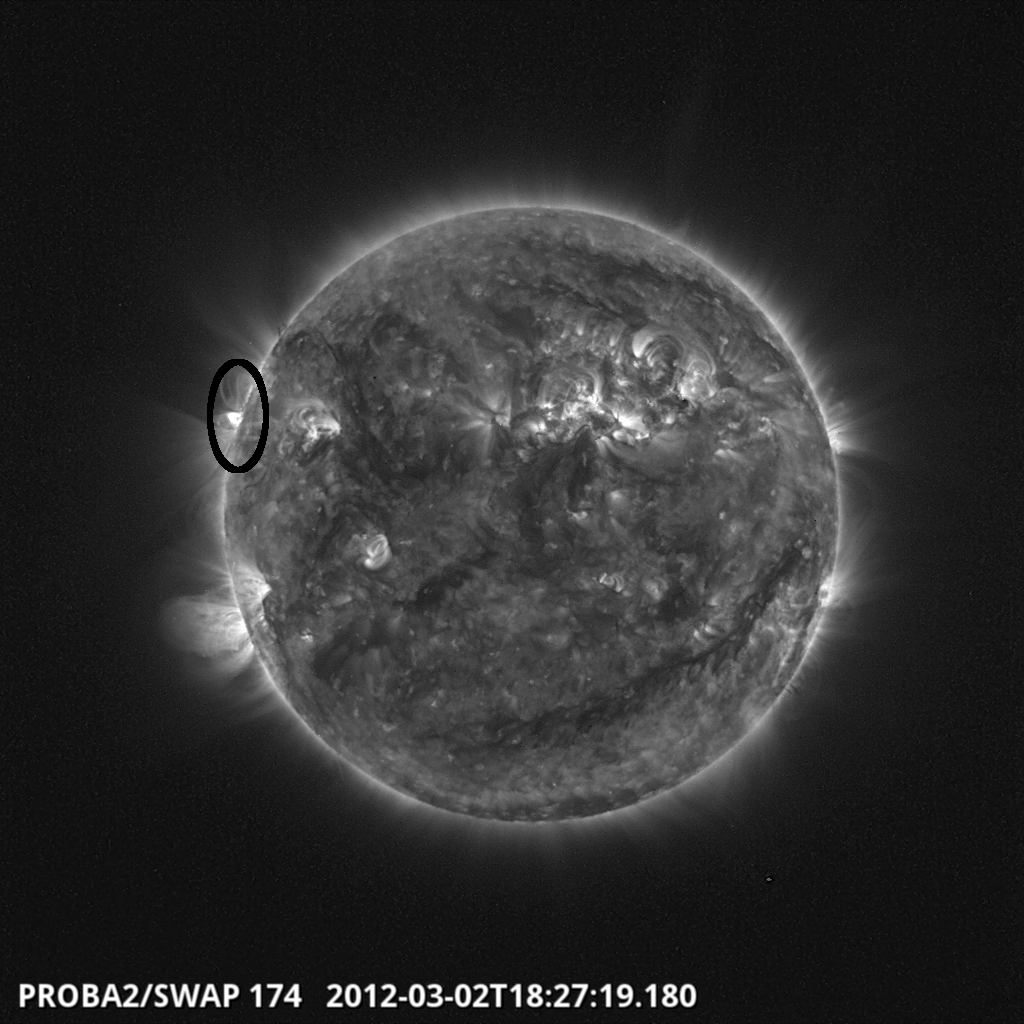
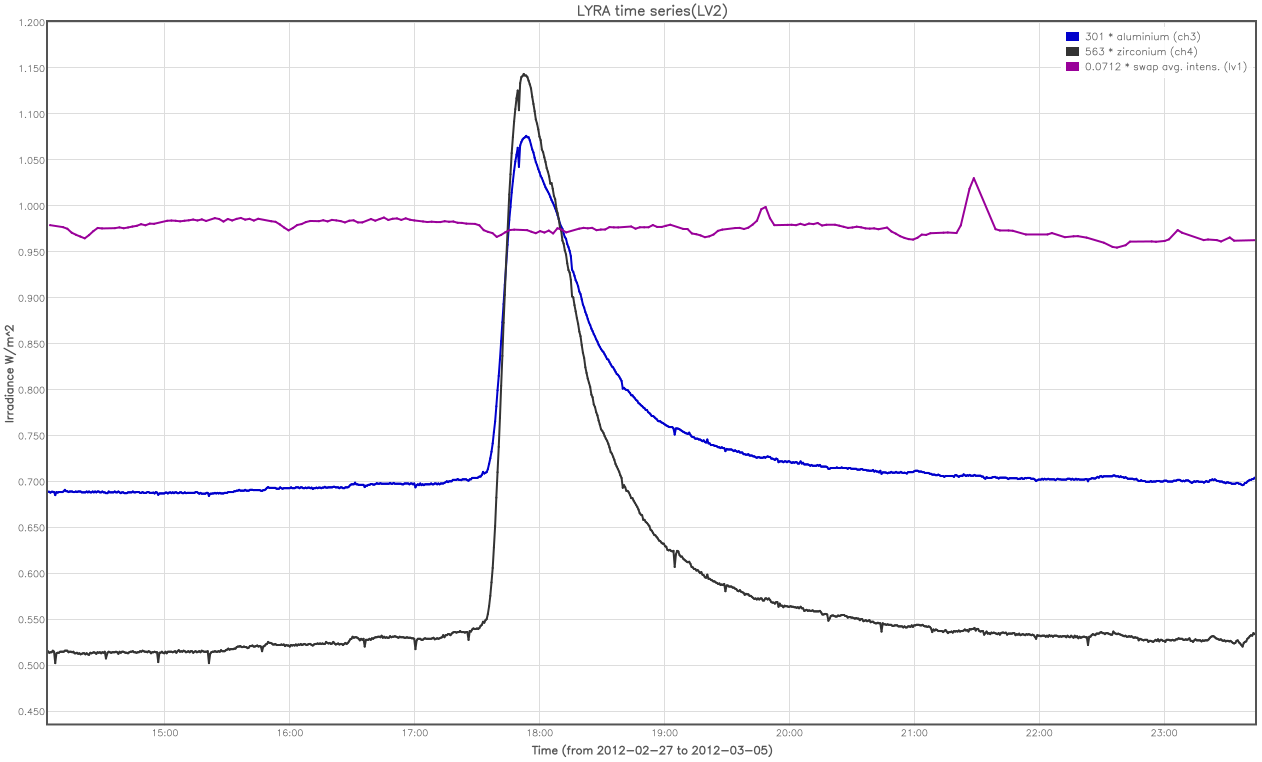
M2.0 Flare on Sun March 04 at 11h57
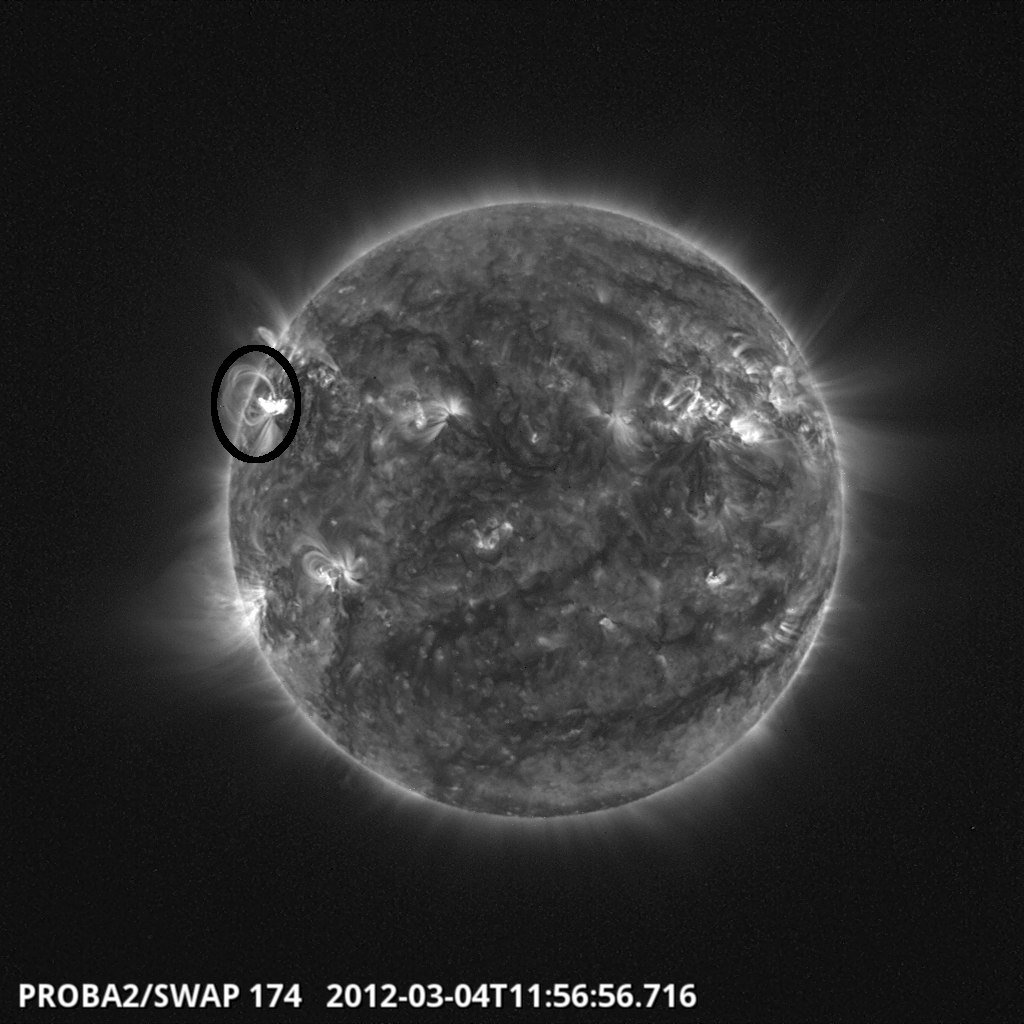
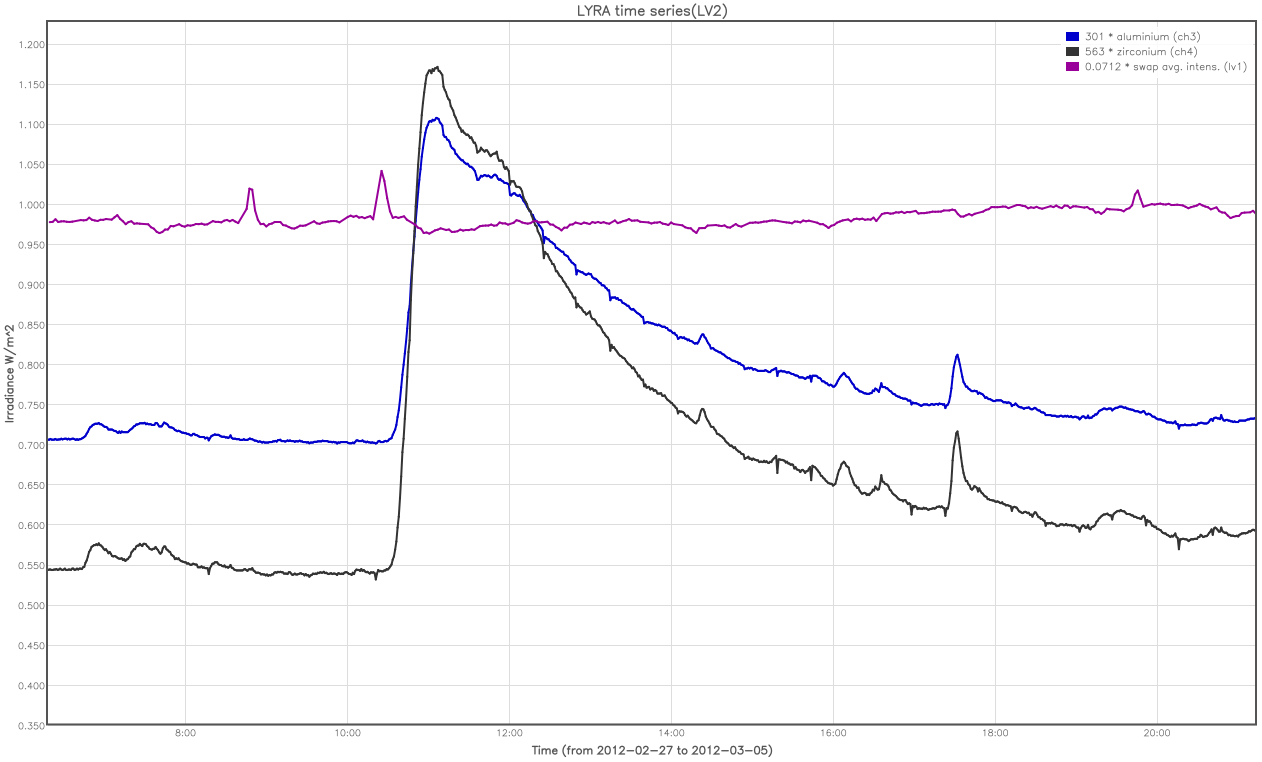
X1.1 Flare on Mon March 05 at 04h28
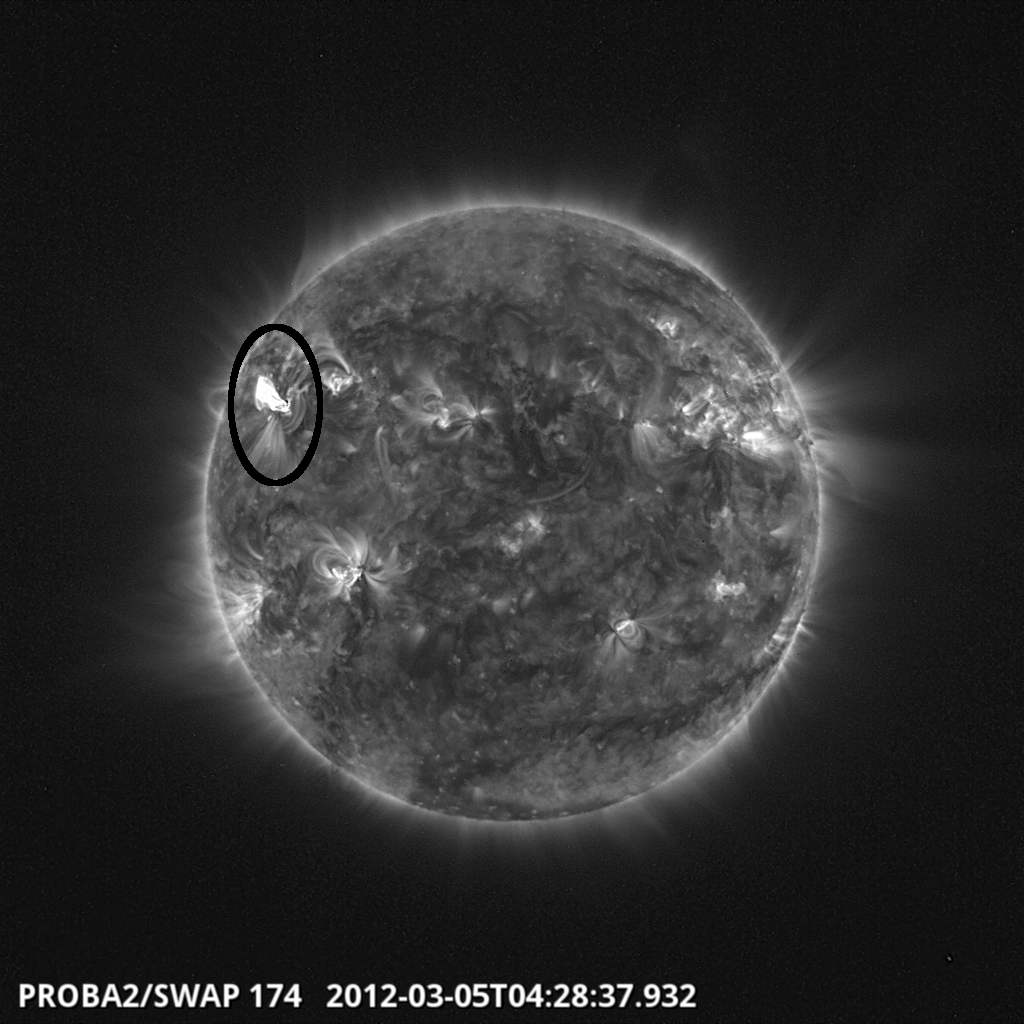
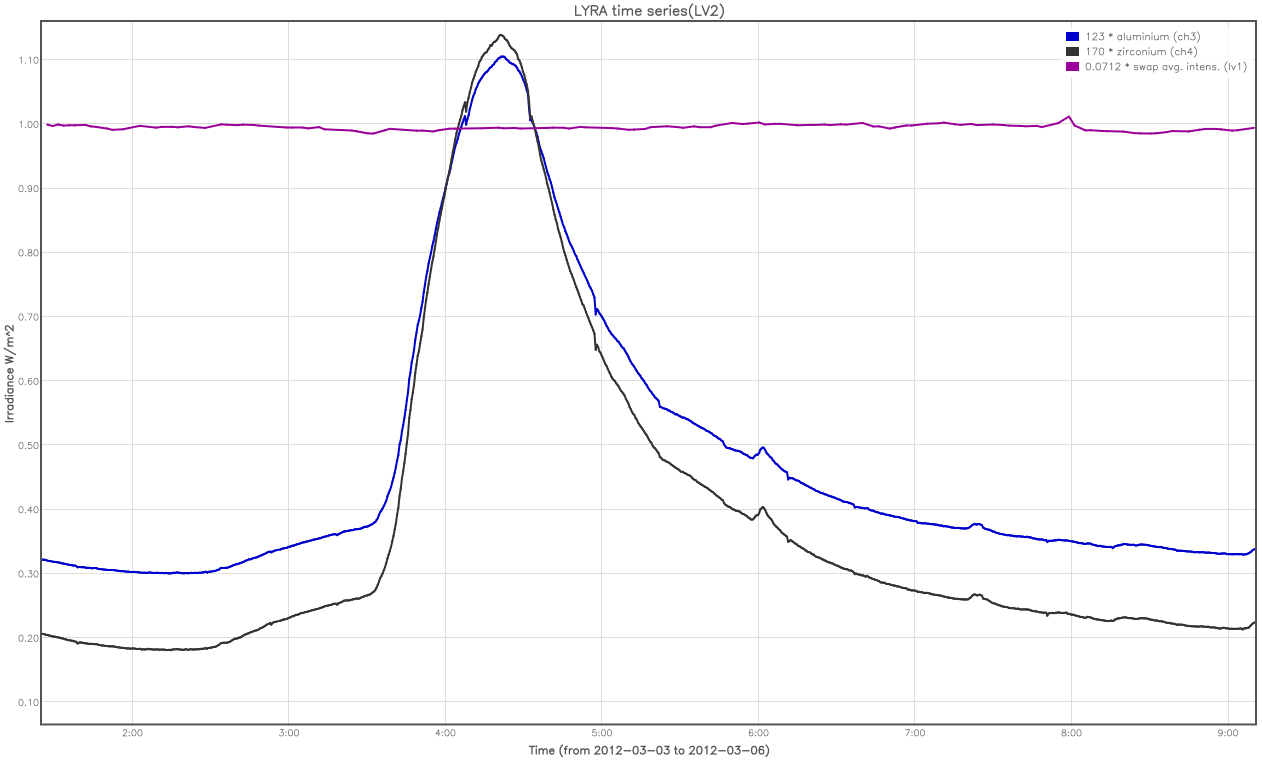
SWAP images and SAA intensity map
We studied the evolution of the number of pixels automatically detected as spiky, i.e. standing out in their spatial neighborhood, in the series of SWAP images. The following maps include the whole PROBA2 mission data. The aim is to study the influence on SWAP of the trapped particles in the Earth's magnetic field and of the solar energetic particles (SEP) and to try to understand the evolution of the total dose received by the instrument (e.g., detected on-board memory errors).
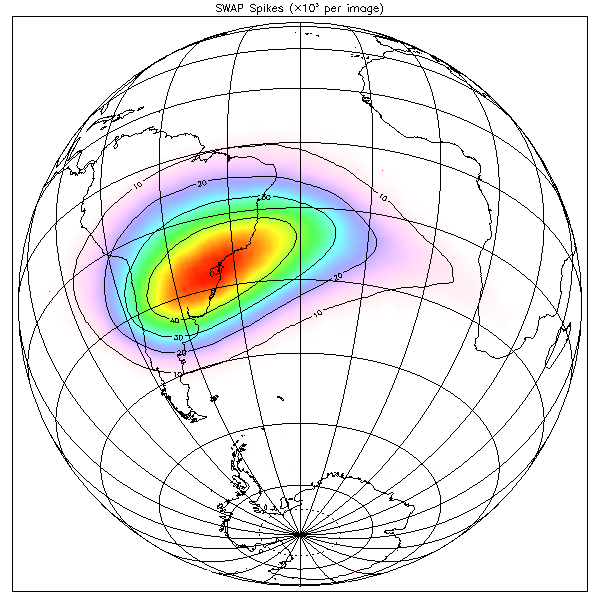
Map of the accumulated number of spikes detected in the SWAP images
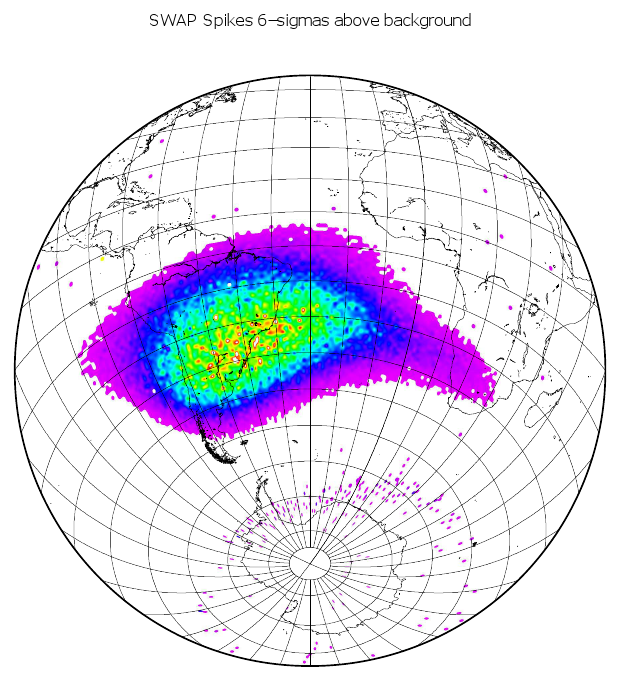
Map of deviations above 6 sigma in the time series of spikes detected in the SWAP images
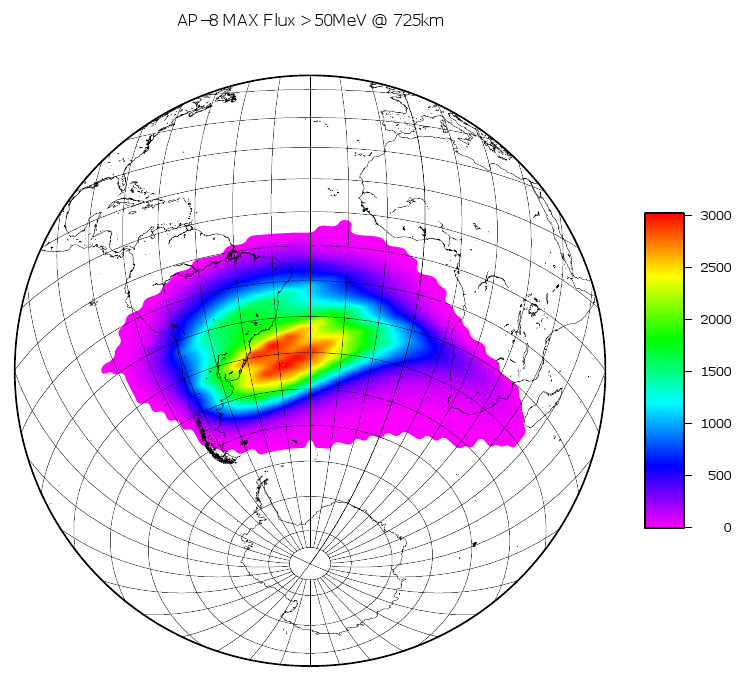
Map of omni-directional flux of protons with energy higher than 50 Mev at a height of 725km, AP-8 trapped proton model from SPENVIS at maximum solar activity.
Note that the South Atlantic Anomaly (SAA), as based on data from the SWAP images, has drifted westward towards the South American coastline and is no longer situated above the South Atlantic (as is the case in the SPENVIS graphs below).
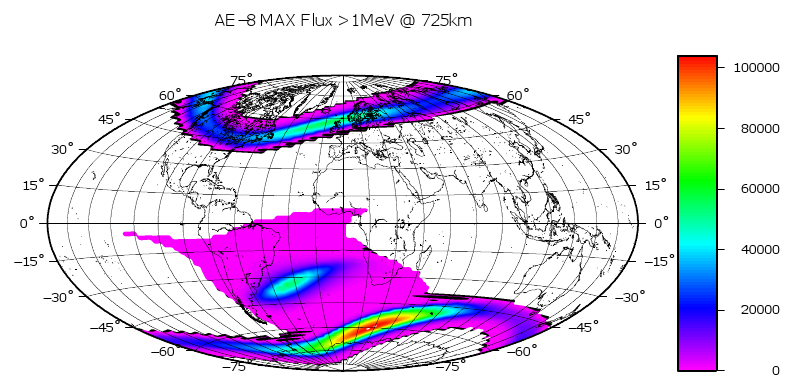
Map of omni-directional flux of electrons with energy higher than 1Mev at a height of 725km, AE-8 trapped electron model from SPENVIS at maximum solar activity.
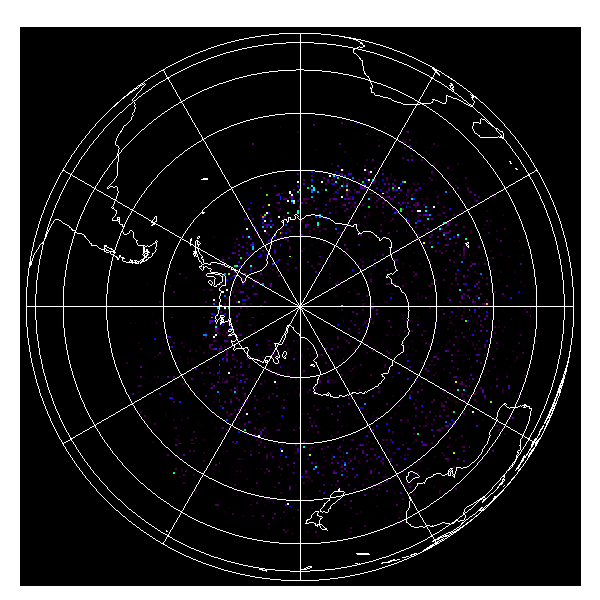
SWAP registered spikes in the southern auroral band
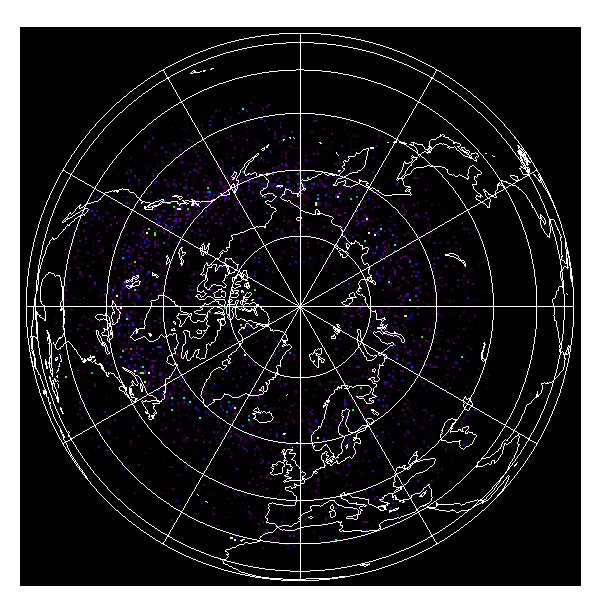
SWAP registered spikes in the northern auroral band
Preliminary investigations show that the major southern auroral events can be linked to disturbed geomagnetic conditions in Apr, May 2010 and Sep 2011. We suspect that some of the registered events could be associated to SEPs. Further analysis will determine in more detail the contributing factors.
Start : 2012-03-12 - End : 2012-03-16
An overarching theme of the meeting is to cover how different
regions in the solar atmosphere are coupled, with a particular
focus on the chromosphere
, the region where most of the
non-thermal energy in the solar atmosphere is deposited. The
meeting will focus on quiescence, i.e., the non-flaring,
non-eruptive state of the atmosphere in coronal holes, quiet Sun
and active regions.
The major goals of this meeting are:
* Provide an overview of recent insights in how different
regions in the solar atmosphere are coupled and energized with a
focus on how magnetic flux, mass and energy are transported through
the atmosphere. This will be done by confronting recent advanced
numerical models with state-of-the-art high resolution
observations.
* Provide the community with an overview of outstanding
challenges, such as the heating of the chromosphere
, its connection to the corona, the
role and interpretation of chromospheric magnetism in revealing the
connectivity and energy deposition in the low solar atmosphere, and
the relative role of waves and braiding in the heating of coronal
plasma
.
* Prepare the community to fully exploit the novel diagnostic
capabilities that will be provided by future missions such as the
Interface Region Imaging Spectrograph (IRIS) small explorer, due
for launch in late 2012, ESA
's Solar Orbiter, or
Japan's Solar C mission. This will be done in part by
providing tutorial and discussion sessions on optically thick
chromospheric diagnostics (including spectropolarimetry) which are
a major part of the diagnostic capabilities of both missions, and
in part by illustrations of how detailed comparisons between
synthetic observables from numerical models and observations lead
to physical insights.
Site:
http://sdo4.lws-sdo-workshops.org/
Start : 2012-04-18 - End : 2012-04-20
We are hosting a conference celebrating the careers of Prof.
George Doschek from NRL and Prof. Tetsuya Watanabe from NAOJ
focussing on the topic of Spectroscopy of the Dynamic Sun.
George Doschek has played a major part in space solar
spectroscopy for many decades. Following a key role in exploiting
Skylab
data, he made huge contributions to
the design and build of instruments on board the P78-1, Yohkoh
and Hinode missions, being US PI
for the Hinode EIS. His knowledge of spectroscopy is recognized and
respected internationally and he has published very many papers on
high temperature solar plasmas.
Tetsuya Watanabe is a leading spectroscopist in Japan. Following
work with stellar atmospheres, he has been involved from the start
of Japanese space solar physics with significant roles in the Bragg
spectrometers the Tansei 4, Hinotori and Yohkoh
missions. He is Japanese PI for
Hinode EIS. He has published extensively on solar X-ray and EUV
spectra.
This conference will focus on recent results using spectroscopy
to probe fundamental questions in solar physics.
Website:
http://msslxr.mssl.ucl.ac.uk:8080/SolarB/spectrosun/index.jsp
Start : 2012-04-22 - End : 2012-04-27
The EGU General Assembly 2012 will bring together geoscientists
from all over the world into one meeting covering all disciplines
of the Earth, Planetary and Space Sciences. Especially for young
scientists the EGU appeals to provide a forum to present their work
and discuss their ideas with experts in all fields of geosciences.
The EGU is looking forward to cordially welcome you in Vienna.
Space weather
related sessions:
Impact of solar and geomagnetic variabilities on the
Earth's lower,middle and upper atmospheres (Thierry Dudok de
Wit, Jean Lilensten, F.-J. Lübken, M. Kaufmann and P.
Preusse)
This interdisciplinary session focuses on the multiple impacts
of solar activity on climate variability. The session will address
both forcing mechanisms such as solar spectral irradiance,
geomagnetic perturbations and galactic cosmic rays, and the
response of the upper, middle and lower atmosphere. Special
attention will be payed to the solar flares and geomagnetic storms
as well as to the role of the long-term trends of the solar
activity, in particular, in global climate changes and modern
global warming. Papers involving the physical processes in the
ionosphere
and stratosphere
will be welcome in the first place.
The objective is to go beyond correlation analyses and gain a
better quantitative understanding of the different contributions of
solar variability to the terrestrial environment.
More information:
http://meetingorganizer.copernicus.org/EGU2012/provisionalprogramme/CL
Space Weather
and its Effects on Terrestrial and
Geo
-Space Environments: Science and
Applications (Viviane Pierrard (BIRA-IASB, Belgium), Hanna
Rothkaehl (Space Research Centre PAS, Poland), Norma Crosby
(BIRA-IASB, Belgium)
This session gathers together scientists with expertise in
various fields of solar-terrestrial physics that deal with the
effects of space phenomena on different levels of geo
-space. Effects range from those
observed on spacecraft related activities all the way down to
Earth, including technological systems, human health and the
Earth's climate. We welcome contributions (theoretical and
observational) as well as applied (effects on terrestrial and geo
-space environments), on all
aspects of space weather
. Contributions related to the ESA
Space Situational Awareness (SSA)
programme, or the EU FP7 programme, are very welcome. We look
forward to a dynamic and interdisciplinary session.
Website:
http://meetings.copernicus.org/egu2012/
Start : 2012-04-24 - End : 2012-04-27
Space Weather
Workshop is an annual conference
that brings industry, academia, and government agencies together in
a lively dialog about space weather
. What began in 1996 as a
conference for the space weather
user community, Space Weather
Workshop has evolved into the
Nation’s leading conference on all issues
relating to space weather
.
The conference addresses the remarkably diverse impacts of space
weather
on today’s
technology. The program highlights space weather
impacts in several areas, including
communications, navigations, spacecraft operations, aviation, and
electric power. The presentations and discussions at the Space
Weather
Workshop also focus on identifying
the highest priority needs for operational services that can guide
future research and identifying new high-value capabilities that
can be transitioned into operations. The conference fosters
communication among researchers, space weather
service providers, and users of
space weather
services.
Researchers have the opportunity to discuss relevant research in
many areas of the space environment. Recent progress in large-scale
modeling efforts will be featured; while new developments in
Sun-to-Earth coupled modeling systems will also be a highlight.
Website:
http://www.swpc.noaa.gov/sww/
Start : 2012-04-30 - End : 2012-05-04
As the impact of space weather
and climate on daily life is
becoming more important, it is timely to discuss the latest reseach
on the solar origin of these phenomena. Recent advances in
helioseismology have demonstrated that subsurface dynamics are
closely associated with aspects of solar activity from the
long-term timing of the solar cycle to the short-term eruption of
solar flares. The advent of synoptic vector magnetic field
measurements is opening up a new path for research on active
regions, flares and CME
's. Coronal magnetic field
measurements should become available in the next 5-10 years,
supplying another physical constrain on space weather
events.
Website:
http://www.nso.edu/general/workshops/2012/
Start : 2012-05-09 - End : 2012-05-11
The workshop on 'Advances on Space Radiation and Plasma
Environment Monitoring, Data
Analysis Methods and Flight Opportunities Workshop' is the forth of
a series of workshops proposed under the auspices of the Space
Environments and Effects Network of Technical Competences
established to further cooperation in Europe.
The number of flying or ready to fly European radiation and
plasma
instruments has increased
significantly since the last SEENoTC workshop on the subject in
2008 and a round-table at CNES in 2009. Research programmes have
also made good progresses in investigating innovative technologies
and new concepts designs which will allow a substantial reduction
of mass, power and data rate budgets compared to traditional
instrumentation, whilst providing equivalent or higher detection
efficiency. With many future missions in Navigation,
Telecommunications, Exploration, Science, GMES domains flying in
severe radiation environments and carrying highly sensitive
components and systems, the need for such radiation instrumentation
is increasing. Accurate measurements of the Space Environment plays
also a crucial role in improvement of radiation enviroment models
and the development of the space weather
services required by the Space
Situational Awareness programme.
The intention of this workshop is to provide a venue for
discussing the latest developments on space plasma
and radiation environments and
effects instrumentation, to examine possible flight opportunities
for such instruments, and to establish the necessary technical and
management steps necessary to ensure collaboration on future data
analyses, databases, data sharing, and lessons learned from flight
experience. It will also allow further discussion and capture of
explicit experiment needs and further the harmonization of
cooperation on instrument development, flight plans and data
exploitation.
Website:
http://www.congrexprojects.com/12C16
Start : 2012-05-20 - End : 2012-05-20
For more information:
http://eclipse.gsfc.nasa.gov/SEgoogle/SEgoogle2001.html
Start : 2012-05-20 - End : 2012-05-25
Helioseismology and asteroseismology are the only means to
investigate the interior of the Sun and stars. They are crucial for
understanding the structure and evolution of stars, which produce
all chemical elements in the universe heavier than helium, and
which host and influence planets which may carry life.
Understanding the physics of the Sun's interior is essential
for understanding the solar dynamo and consequently for predicting
solar magnetic activity, which has a severe impact on the operation
of space missions. Understanding the interior of the stars is
essential for understanding those astronomical objects that host
and influence planets. With the suite of the latest instruments and
missions, e.g. BiSON, GONG, SOHO
, SDO, Hinode and Picard for solar
exploration and MOST, CoRoT, Kepler, BRITE, SONG for stellar and
exoplanetary research, the precision on the seismically determined
quantities, e.g. flows in the solar interior or the ages and radii
of stars will be greatly improved. This will allow creating new
knowledge in solar physics and astrophysics and therefore makes the
proposed conference particularly timely.
Website:
http://www.esf.org/index.php?id=9140
Start : 2012-05-21 - End : 2012-05-23
The purpose of this workshop is to foster the development of
tools to interpret current and future measurements of coronal
magnetic fields in order to improve our understanding of the Sun
and the sources of Space Weather
. This is motivated by the
anticipated rapid growth over the next decade in our remote sensing
capabilities of the coronal plasma
. These new capabilities can only
be exploited with improvements in our ability to model the
polarized radiative transfer through the coronal plasma
and by coupling information on the
coronal magnetic field and plasma
conditions with models extending to
the near Earth environment.
This workshop will include a wide variety of subjects including,
but not limited to, instrumentation, the interpretation of
polarimetric signals in EUV and UV emission lines, techniques to
mitigate the effects of line-of-sight integration effects of the
optically thin corona such as tomographic inversions and forward
modeling, models of the polarized radiative transfer at radio
wavelengths, extrapolation and MHD modeling of coronal magnetic
fields, as well as discussions on how to move forward with coupling
these inferences of the coronal plasma
with models of heliospheric
structure and Space Weather
prediction.
Website:
http://www.hao.ucar.edu/CoronalMagnetismWorkshop/index.php
Start : 2012-05-31 - End : 2012-06-07
The 2012 Heliophysics Summer School will focus on the science
underlying current and future heliophysical missions, including but
not limited to MMS, Themis
, RBSP, IRIS, SDO, and Solar Probe
Plus. After providing students with broad overviews of the solar
atmosphere, the solar wind
, the Earth’s
magnetosphere
, and ionosphere
, the course will cover the basic
concepts and unanswered questions pertaining to magnetic
reconnection, shocks, plasma
instabilities, turbulence, and
heating, and the manner in which these concepts and questions
affect our understanding of phenomena such as substorms, radiation
belt and chromospheric dynamics, solar wind
turbulence and particle heating,
and heliospheric shocks.
Link:
http://www.vsp.ucar.edu/Heliophysics/summer-about-over.shtml
Start : 2012-06-04 - End : 2012-07-27
The Los Alamos National Laboratory established a summer school
in 2011 dedicated to space weather
, space science and applications.
Every year we solicit applications for the Los Alamos Space Weather
Summer School. This summer school
is sponsored by IGPP (Institute of Geophysics and Planetary
Physics) and PADSTE (Principal Associate Directorate for Science,
Technology and Engineering), and PADGS (Principal Associate
Directorate for Global Security) and has been established to bring
together top space science students with internationally recognized
researchers at LANL.
Website:
http://www.swx-school.lanl.gov/
Start : 2012-06-04 - End : 2012-06-09
The Space Weather
Integrated Forecasting Framework
network (http://www.swiff.eu) organizes in June 2012 the
“First European School on Fundamental processes
in space weather
, a challenge in numerical
modelingâ€. The School will focus on the theoretical
study of Space plasmas, in particular on those systems where a
continuous energy injection flow leads to a self-consistent
coupling of the large scale, low frequency motions with the small
scale, high frequency fluctuations including kinetic effects.
Progress in this field heavily relies on numerical simulations
that, as a matter of fact, are nowadays more similar to laboratory
experiments than to theoretical exercises. This is true in terms of
planning efforts in the preparatory phase, of manpower required, of
data analysis and cost. The understanding of these processes
represents a fundamental step for the future of Space Weather
models.
Website:
http://www.df.unipi.it/~califano/SWIFF_School/EU_School_on_Space_Weather_fundamental_plasma_processes.html
Start : 2012-06-04 - End : 2012-06-08
During the last thirty years there has been steady progress in
our understanding of the influence that space weather
has on the state of human health
both in Space and at Earth. This development is mainly based on
research conducted on humans onboard space stations and
spacecrafts, as well as on ground based observations and
experimental studies simulating conditions in space. This
interdisciplinary field of research requires a wide exchange of
expertise in various topics. Only with a global approach it will be
possible to establish a mutual understanding, in regard to defining
the current state of this research problem as well as identifying
what should be pursued in future research activities.
Website:
http://swh2012.cosmos.ru/
Start : 2012-06-06 - End : 2012-06-10
We announce the 'Second Remote Sensing of the Inner Heliosphere
Workshop' to be hosted by
Aberystwyth University and held in Aberystwyth, Wales, UK, 06-10
June 2011. The workshop aims to gather experts from the various
fields of remote-sensing observations of the inner heliosphere
, including white-light, EUV, and
radio observation, together with modellers in order to tackle key
outstanding science issues, establish closer working relations, and
devise the best ways to move the field forward. In addition, the
science learned from remote-sensing observations is key to
improving our capabilities of space weather
forecasting. The workshop also aims
to look at ways in which we can more easily and efficiently share
and access the various types of data between individual groups and
sub-communities, ways in which we model the inner heliosphere
looking at the advantages and
disadvantages of the available modelling, updates on present and
future remote-sensing capabilities - including those on the STEREO
/SDO/Solar Orbiter/Solar Probe+
Missions, and progress on use of the LOw Frequency ARray (LOFAR)
and Murchison Widefield Array (MWA) radio arrays - pathfinders for
the Square Kilometre Array (SKA) - linking remote-sensing
observations of the inner heliosphere
with those closer-in to the Sun as
well as with in-situ measurements, and investigating further the
ways in which these data sets all complement each other and are
necessary to gain knowledge and understanding of the fundamental
physical processes that occur within the inner heliosphere
.
Website:
http://heliosphere2011.dph.aber.ac.uk/
Start : 2012-06-17 - End : 2012-06-22
The Thirteenth International Solar Wind
Conference, organized by the
University of Alabama in Huntsville's Center of Space Plasma
and Aeronomic Research (CSPAR) and
the the University of California, Berkeley's Space Sciences
Laboratory, will take place at Sheraton Keauhou Resort on Big
Island, Hawaii, USA, from 17 to 22 June 2012. Please note that
scientific sessions will start on Monday 18 June.
The conference will conform to the traditional solar wind
themes, addressing the current
state of knowledge in the relevant fields of solar and heliospheric
physics. In particular, the conference will focus on the physics
ofthe corona, the origin and acceleration of the solar wind
, its dynamical interactions
throughout the heliosphere
and the interstellar medium and its
boundaries. The program will be composed of both invited lectures
and contributed talks and posters.
Website: http://www.sw13.org/
Start : 2012-06-25 - End : 2012-06-29
SHINE stands for Solar Heliospheric and INterplanetary
Environment. It is an affiliation of researchers within the solar,
interplanetary, and heliospheric communities, dedicated to
promoting an enhanced understanding of the processes by which
energy in the form of magnetic fields and particles are produced by
the Sun and/or accelerated in interplanetary space and on the
mechanisms by which these fields and particles are transported to
the Earth through the inner heliosphere
.
SHINE research focuses in particular upon the connection between
events and phenomena on the Sun and their relation to solar wind
structures in the inner heliosphere
. The goal of SHINE activities is
to enrich and strengthen both physical understanding and predictive
capabilities for these phenomena.
Website:
http://shinecon.org/Current%20Meeting.htm
Start : 2012-06-25 - End : 2012-06-28
Toulouse will host the most important players in the global
aerospace industry, particularly those focusing on space
applications. It will provide the opportunity to meet with more
than 1000 experts, service providers, clients, users, researchers
and students from all over the world.
Website:
http://www.toulousespaceshow.eu/tss12/en/
Start : 2012-07-01 - End : 2012-07-06
We have the pleasure to invite you in July 2012 to attend the
European Week of Astronomy and Space Science, the now classical
Ewass meeting, formely known as Jenam. In 2012, the meeting will
take place in Rome, Italy, at the Pontificia UniversitÃ
Lateranense.
Website:
http://www.ifsi-roma.inaf.it/ewass2012/
Start : 2012-07-04 - End : 2012-07-07
The Sun is the most important astronomical object for humankind
with solar activity having a direct impact on Earth. From a
fundamental point of view the Sun offers an exceptional physics
laboratory where the interactions of the astrophysical plasma
and the magnetic field can be
studied in detail.
The BUKS workshops on MHD waves and oscillations of the solar
atmosphere is organised by the following research groups from
Belgium, Spain and the UK:
* The Centre for Plasma
Astrophysics, Katholieke
Universiteit Leuven, Belgium
* The Solar Physics & Space Plasma
Research Centre, University of
Sheffield, UK
* The Solar & Magnetospheric Theory Group, University of
St Andrews, UK
* The Centre for Fusion, Space & Astrophysics,
University of Warwick, UK
* The Solar Physics Group, Universitat de les Illes Balears,
Spain
* The Astrophysics Research Centre, Queen's University
Belfast, UK
BUKS2012 will also honour the contributions of Prof Marcel
Goossens to the field of MHD waves and offer an opportunity to
celebrate his 65th birthday.
Website:
https://habu.pst.qub.ac.uk/groups/buks2012/
Start : 2012-07-08 - End : 2012-07-11
The 23rd Annual NASA
Space Radiation Workshop is
tentatively scheduled for July 8–11, 2012 in
Durham, North Carolina. More information follows later.
Website: not available yet
Start : 2012-07-11 - End : 2012-07-15
From 11th-15th of July 2012 international researchers, policy
makers, business leaders and global media will gather in the
Convention Centre in Dublin, Ireland to take part in the
Euroscience Open Forum (ESOF), 2012. A science conference like no
other, ESOF 2012 is unique in representing the largest convergence
of the Sciences, Humanities and Culture in Europe in 2012. Some of
the keynote speakers at ESOF 2012 will include Craig Venter,
Rolf-Dieter Heuer, Charles Bolden, Mary Robinson, and Bob
Geldof.
Website: http://www.esof2012.org/
Start : 2012-07-14 - End : 2012-07-22
The 39th COSPAR Scientific Assembly will be held at the Global
Education Centre, 2 Infosys Training Centre Mysore, Karnataka India
from 14 - 22 July 2012. This Assembly is open to all bona fide
scientists.
Website:
http://www.cospar-assembly.org/
Start : 2012-07-16 - End : 2012-07-27
The CISM Space Weather
Summer School is a 2-week intensive
program targeted to first-year graduate students but also attended
by undergraduates and space weather
professionals. The daily schedule
includes morning lectures, followed by afternoon laboratory
sessions where students further explore the day's topics using
CISM model simulations, observational data, and sophisticated
visualization tools. CISM is making the laboratory materials
publicly available for use by others, for example to supplement
lecture courses or for student independent study. The deadline for
applications is May 1.
Website:
http://www.bu.edu/cism/SummerSchool/overview.html
Start : 2012-08-06 - End : 2012-08-10
The IRC's International Radiation Symposium 2012 provides a
forum for the scientific community to exchange recent results and
evolving ideas relevant to many areas of atmospheric radiation.
Quadrennially convened, the IRS assembles a global network of
scientists and students engaged in studies pertaining to the
Earth-atmosphere-Sun system, and encourages international
cooperation in radiation research crucial to understanding and
predicting Earth's dynamic climate and habitability. The IRC
invites you to Berlin and welcomes your participation in this
endeavor.
Website: http://irs2012.org/
Start : 2012-08-13 - End : 2012-08-17
An international body established since 2003, the Asia Oceania
Geosciences Society (AOGS) aims to promote geosciences and advance
its applications for the benefit of humanity in Asia and
Oceania.
Sessions:
* Atmospheric Sciences
* Biogeosciences
* Hydrological Sciences
* Ocean Sciences
* Planetary Sciences
* Solar & Terrestrial Sciences
* Solid Earth Sciences
* Interdisciplinary Working Groups
Website:
http://www.asiaoceania.org/aogs2012/public.asp?page=home.htm
Start : 2012-08-13 - End : 2012-08-16
You will have a noticed the slight re-branding of these
workshops from ‘Image’ to
‘Information’ processing. We
think it is time to expand the attention of these workshops to
discuss more generally how information about the Sun can be
derived, stored, shared, transformed and analyzed using appropriate
techniques from many other disciplines. We will still be covering
image processing and computer vision techniques applied to solar
physics, but we will also be including other topics such as machine
learning, data mining and new computing strategies. The re-branding
simply acknowledges and makes explicit what the community has been
doing to determine the physics of the Sun.
Link: http://www.sipwork.org/
Start : 2012-08-20 - End : 2012-08-31
In August 2012 China will for the first time host the General
Assembly of the International Astronomical Union in Beijing. This
triennial gathering of astronomers from around the world to discuss
and debate the most recent discoveries about the universe is an
important part of the vitality of our science. Astrophysics remains
one of the most exciting areas of human endeavor, and the venue of
the Beijing GA will be equally impressive: the new China National
Convention Center that is housed in the Olympic Park in a
beautiful, spacious building and area that is full of amenities for
conference participants and visitors.
The contributions of Chinese astronomy to human knowledge and
our understanding of the cosmos have been of historical
significance, from the earliest to modern times. GA participants
will have an opportunity to experience the wide range of
astronomical activities now taking place in China that include new
projects, facilities, and institutes. They will also report on, and
hear, the latest research results from every field of astronomy. An
exciting scientific programme is being developed that will hold the
interest of everyone. I am pleased to welcome all Union members and
invited guests to join us in Beijing for what will be a memorable
General Assembly.
Website:
http://www.astronomy2012.org
Start : 2012-09-20 - End : 2012-09-23
Every year, the International Meteor
Organization (IMO) organizes the
International Meteor
Conference (IMC). This conference
deals with all aspects of meteor
observation as well as the
underlying physics and is aimed at both amateurs and
professionals.
The International Meteor
Organization (IMO) will hold the
31st annual International Meteor
Conference (IMC) on La Palma,
Canary Islands, Spain, from 20 till 23 September, 2012. The
conference will be organized by the Astro Travels agency in
collaboration with the Cabildo of La Palma island authority which
will sponsor this event.
Website:
http://www.imo.net/imc2012/
Start : 2012-10-01 - End : 2012-10-05
At the forthcoming 63rd International Astronautical Congress in
Naples a special session on the theme 'Effects of Space Weather
on GEO
Satellites' will be held as part of
the 25th Symposium on Space Policy, Regulations and Economics.
This session will discuss case histories and mechanisms of
effects of space weather
on GEO
satellites, models for prediction,
and mitigation approaches. We would like to invite you to consider
submitting abstracts for this session.
The call for papers can be found at
The
deadline for abstract submission is 29 February 2012.
http://www.iafastro.org/docs/2012/iac/IAC2012_CallForPapers.
Website: http://www.iac2012.org/
Start : 2012-10-22 - End : 2012-10-24
2012 – 2013 is expected to be years with high
solar activity. This can trigger larger solar storms which can
generate geomagnetic induced currents (GIC
) on the earth. GIC
can affect the normal operation of
specific industrial operations and critical infrastructure (e.g
power grids, telecom, navigation systems, etc).
During space weather
events, like solar storms, electric
currents in the magnetosphere
and ionosphere
experience large variations, which
manifest also in the earth's magnetic field. These variations
induce currents (GIC
) in conductors operated on the
surface of the earth. Electric transmission grids and buried
pipelines are common examples of such conductor systems. GIC
can cause problems, such as
increased corrosion of pipeline steel and may disturb and possible
damaged high-voltage power transformers and it can also have
damaging effects on communication systems, navigation systems and
oil and gas operations.
Vulnerable industries are the oil and gas industry, railways,
telecommunication industry, navigation industry and not at least
the society, which is very vulnerable concerning short or long term
interruption of critical infrastructure.
The conference will focus on increasing the general knowledge of
solar storms, space weather
and GIC
and the possible consequences for
different industries and critical infrastructure, and look into
reasonable means of protection, and consider possible early warning
solutions.
More information:
http://www.tiems.info/images/stories/tiems%202012%20oslo%20conference%20call%20for%20papers.pdf
Start : 2012-11-05 - End : 2012-11-09
We are pleased to announce that the Ninth European Space Weather
Week will take place at the
Académie Royale de Belgique, Brussels, Belgium between 5
and 9 November 2012.
This meeting is being jointly organised by the Solar-Terrestrial
Centre of Excellence (STCE), ESA
, the SWWT and the COST ES0803
communities. The local organisation is done by the STCE. This event
will continue to build on the advances made during the first eight
European Space Weather
Weeks held between 2004 and
2011.
Website:
http://www.sidc.be/esww9/
Start : 2012-11-06 - End : 2012-11-09
The International Symposium on Solar-Terrestrial Physics will be
held during November 6 - 9, 2012 at the Indian Institute of
Science, Education and Research, Pune, India. This meeting under
the aegis of the SCOSTEP is expected to draw leading scientists
from around the world in the increasingly important,
interdisciplinary fields of Solar activity and its impact on
geospace and life on the Earth. With major observational solar
facilities being planned in India, this meeting is especially
pertinent in the Indian context.
The meeting is expected to involve professional scientists as
well as graduate students, and will have a mixture of invited and
contributed talks and posters. There will also be a one-day
tutorial for the benefit of young people beginning work in the
field of solar-terrestrial physics.
Website:
http://www.iiserpune.ac.in/~isstp2012/
Start : 2012-11-12 - End : 2012-11-16
As we emerge from one of the deepest and longest solar minima on
record, with a new and powerful eye on the Sun -SDO- we invite all
those with an interest is solar activity to gather in beautiful
Palm Cove, Australia to review and assess our current knowledge and
understanding of our magnetic star
, and to experience the awe and
wonder of a total solar eclipse on November 14, 2012.
Website:
http://moca.monash.edu/eclipse/
Start : 2012-11-13 - End : 2012-11-13
For more information:
http://eclipse.gsfc.nasa.gov/OH/OH2012.html#SE2012Nov13T
Start : 2012-11-30 - End : 2012-12-05
The overarching objective of the conference is to examine the
connections amongst the phenomena that lead to solar eruptive
events. The current state of themes includes:
* Measuring the Coronal Magnetic Field;
* Connections to, and Reactions of, the Large-Scale Corona;
* Large-scale Magnetic Connectivity of Active Regions;
* Transfer of Energy to, and Storage of Energy in, the
Corona;
* The High-Energy Particle - Flare - CME
connection.
Working groups will address topics such as:
* Energy Transfer throughout a Solar Eruptive Event;
* Global Energetics of an Ensemble of Events;
* Coronal Influences to the Lower Atmosphere;
* CME
Initiation and Type II Bursts;
* The Release of Energetic Particles in the Low Corona;
* Flows vs. Waves;
* Microflares/Nanoflares.
Website:
http://hessi.ssl.berkeley.edu/petaluma/index.shtml
Start : 2013-01-13 - End : 2013-01-19
Information coming soon!
Website:
http://sd-www.jhuapl.edu/Aurora/ESSE/index.html
Start : 2013-05-10 - End : 2013-05-10
For more information:
http://eclipse.gsfc.nasa.gov/SEplot/SEplot2001/SE2013May10A.GIF
Start : 2013-11-03 - End : 2013-11-03
For more information:
http://eclipse.gsfc.nasa.gov/SEplot/SEplot2001/SE2013Nov03H.GIF